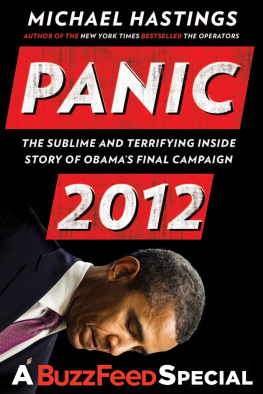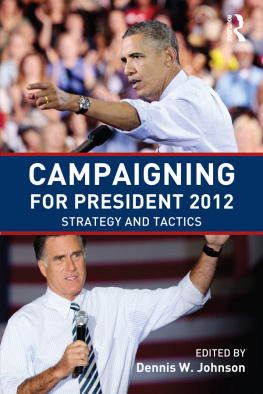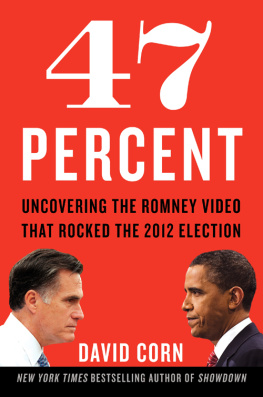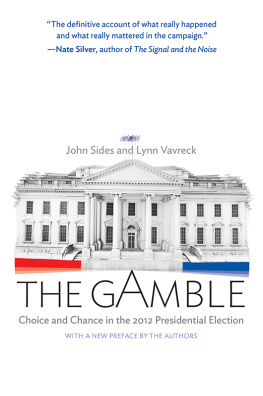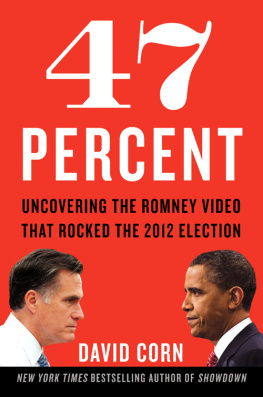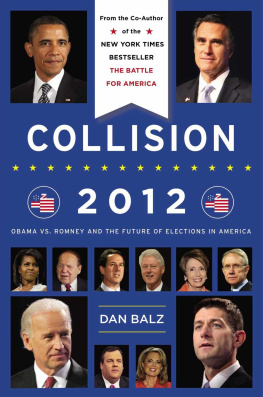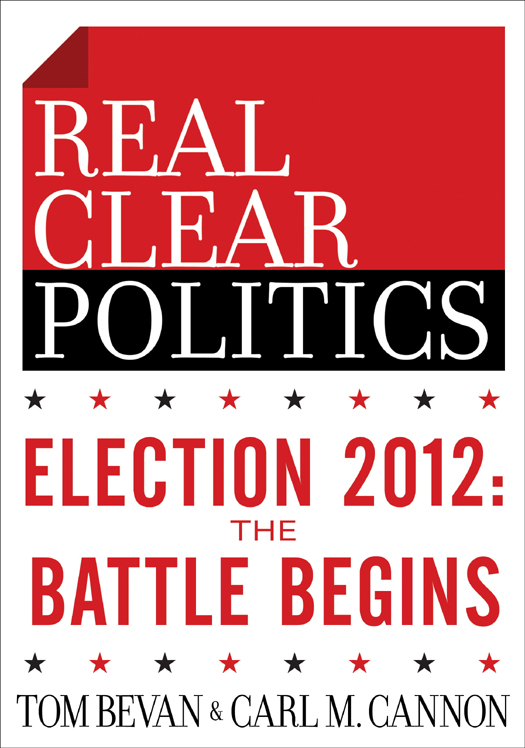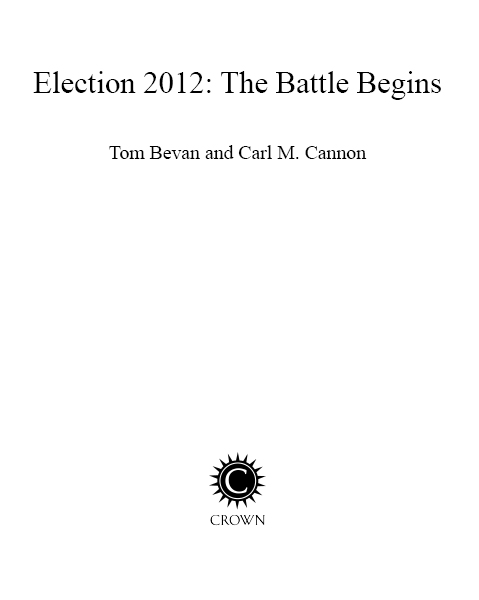Copyright 2012 by Carl Cannon and Tom Bevan
All rights reserved.
Published in the United States by Crown Publishers, an imprint of the Crown Publishing Group, a division of Random House, Inc., New York.
www.crownpublishing.com
CROWN and the Crown colophon are registered trademarks of Random House, Inc.
eISBN: 978-0-307-98662-7
Cover design by Michael Nagin
v3.1
Contents
Prologue
Coming on the heels of the Democratic takeover of the House of Representatives in 2006, Barack Obamas election as the forty-fourth president of the United States left the Republican Party in shamblesor so was the consensus among the experts. There was evidence for this view. Obama had garnered 53 percent of the vote, compared to 46 percent for John McCain, while winning in places such as Virginia and Indiana, which hadnt been carried by a Democrat at the presidential level since 1964. Obama chalked up totals among voters under the age of thirty in a manner so lopsided that it seemed to portend trouble for the Grand Old Party for a generation to come.
Republicans in Distress: Is the Party Over? blared a headline in Time magazine. Republicans never really left the idea business, but Americans havent been buying what theyre selling, and their product line hasnt changed, proclaimed the accompanying essay by Michael Grunwald. Our two-party system encourages periodic pendulum swings, but given current trends, its easy to imagine a third party in the U.S. At this rate, it could be the Republican Party.
This largely unchallenged narrative was proffered by liberals, conservatives, moderates, and libertarians alike. Even before the Land of Lincoln produced an African American president there were signs of big trouble inside the Party of Lincoln. In his last days in office, George W. Bushs job approval ratings were half as high as Ronald Reagans were when he left Washington. Bushs descent into Jimmy Carter territory took a toll on his party, too. By 2007, only 28 percent of Americans expressed a positive view of Bushs political partycompared to 42 percent for the Democratsa far cry from the 1980s when the percentage of Americans identifying themselves as Republican rose from 33 to 42 percent, bringing the GOP to near parity. Moreover, Reagans legacy was responsible for net gains of some 300 Republican seats in state legislatures in both 1980 and 1984and the 1988 presidential election that put Bushs father in the White House was perceived by conservatives as a third Reagan term.
It took thirty years to build the Reagan coalition, wrote political scientist John Kenneth White on the eve of the 2006 elections that put Democrats in control of Congress and made Nancy Pelosi Speaker of the House. It has taken George W. Bush just two years to destroy it.
And who could turn this around? John McCains subsequent defeat in 2008, as well as his daring but divisive choice of Sarah Palin as his running mate, left the Republican Party facing four years without an acknowledged party leader. For once, quadrennial gadfly Ron Paul, a congressman from Texas who had run for president in the Republican primaries, found himself in agreement with the Washington establishment.
The questions now being asked, Paul wrote, are where to go from here and whos to blame for the downfall of the Republican Party?
Fiscal conservatives had a pretty good idea who to blame. Bruce Bartlett, a former Reagan administration budget official, proclaimed that the Republican brand was destroyed by eight years of George W. Bushs policies and infelicitous GOP leadership on Capitol Hill. The party is now widely viewed as corrupt, incompetent, ideologically rigid and out of step with the American mainstream, Bartlett wrote. In addition, the post-Bush GOP was characterized, often by prominent GOP moderates, as being demographically narrow in scope and appeal.
Were excluding the young, minorities, environmentalists, pro-choicethe list goes on, complained Olympia Snowe of Maine, one of two remaining centrist Republicans left in the Senate from the Northeast (the other is also from Maine). Ideological purity is not the ticket to the promised land, Snowe added.
Her point was echoed by conservatives, such as Mississippi governor Haley Barbour, President Reagans one-time political director and the essence of an establishment Republican. Chick-fil-A can get fabulously wealthy with a 20 percent market share, Barbour said. In our business, you need 50 percent plus one.
Aping the hubris that emanated from the White House in the Bush years, gleeful Democrats piled on. Convinced, just as Karl Rove had been in 2004, that winning two elections in a row implied a sweeping realignment in American politics, liberals crowed that they had vanquished their political adversaries. They believed their majority would be durable, lasting, and, given the changing demographics of the country, something akin to a Manifest Destiny for the Democratic Party.
The [Republican] party is going to be driven into their deepest base. It is going to be even more of a white, Protestant, Evangelical, right wing party, predicted Sidney Blumenthal, a liberal journalist turned Clinton adviser who whipped out a quickie 2008 tome, The Strange Death of Republican America: Chronicles of a Collapsing Party.
James Carville, another Clintonista, discussed the sorry state of the Republican Party and Bushs neo-theocracy in a book with a title about as subtle as Carville himself: 40 More Years: How the Democrats Will Rule the Next Generation.
Carville was hardly alone in his heady predictions. The outlook for Republicans is even worse than people think, claimed Democratic think-tank denizen Ruy Teixeira, coauthor of The Emerging Democratic Majority.
Much of the media accepted this reasoning at face value. Even before the votes had been counted in 2008, ABC News was discussing the end of the Republican Party as presently constituted. Even conservative columnist Charles Krauthammer lectured about the current liberal ascendancy. And journalists who werent conservative could scarcely contain themselves.
We Are All Socialists Now, exclaimed a headline over an essay by Newsweek editor in chief Jon Meacham. In many ways, the reading line continued, our economy already resembles a European one. As boomers age and spending grows, we will become even more French.
Time meandered down a similar path. So are the Republicans going extinct? was the question posed by the magazine after the 2008 election. The partys ideasabout economic issues, social issues and just about everything elseare not popular ideas. They are extremely conservative ideas tarred by association with the extremely unpopular George W. Bush, who helped downsize the party to its extremely conservative base.
And what a sorry, dispirited, and minuscule base that wasat least the way the media told it. Sam Tanenhaus, one of many writers who produced a book advising Republicans how to recapture their mojo, summed up the prevailing view in a single sentence: What conservatives have yet to do is confront the large but inescapable truth that movement conservatism is exhausted and quite possibly dead.
* * * * *
A few isolated voices begged to differ. One of them belonged to Ron Paul. More Libertarian than Republican, the idiosyncratic Texas congressman had complained in 2008as he would in 2011that the media mostly ignored him and that the GOP had put hurdles in his way. This criticism was largely true, and not altogether unwarranted, but neither Paul nor his band of loud and loyal disciples were easily dissuaded. In 2007, in events that received almost no news coverage, the keepers of the Ron Paul Revolution had taken to organizing rallies with an intriguing theme.


